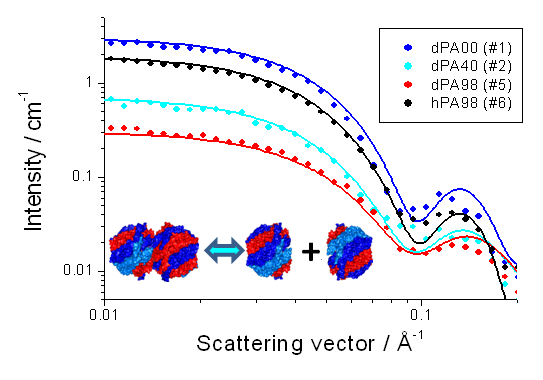Radiation Material Science
Professor
- SUGIYAMA, Masaaki e-mail: sugiyama.masaaki.5n<atmark>kyoto-u.ac.jp
- URADE, Reiko e-mail: urade.reiko.8w<atmark>kyoto-u.ac.jp
Associate Professor
- INOUE, Rintaro e-mail: inoue.rintaro.5w<atmark>kyoto-u.ac.jp
Assistant Professors
- MORISHIMA, Ken e-mail: morishima<atmark>rri.kyoto-u.ac.jp
(concurrent) - SHIMIZU, Masahiro e-mail: shimizu.masahiro.3n<atmark>kyoto-u.ac.jp
(concurrent)
It is well known that a material structure and its dynamical character are deeply related. The interaction between the constituents determines the material structure and the dynamical character is a response of the structural interaction against the external disturbances. In the case of a functional material with a nano-scale structure, it is essential to reveal a mechanism of function to understand its dynamical character based on the structure. Along this line, this research group studies the static and dynamical structures of functional materials with nano-scale structures such as supercritical fluid, polymer aggregates, gel and protein.
Main methods to measure nano-scale structure are scattering techniques with X-ray or neutron: especially, neutron scattering utilizing its ability identifying isotopes, proton and deuteron, is a very powerful tool to reveal a quaternary structure of protein. Recently, we reveal a state of PA28 (Proteasome Activator 28) in an aqueous solution: PA28 is a regulator protein of the 20S proteasome, which is protease for an ubiquitinated protein. Figure 1 shows the SANS analysis of the state of PA28 in an aqueous solution. The structural simulation well reproduces the experimental SANS profiles.
In addition, we are developing a spectrometer and analyzing methods. Therefore, we are joining the TAIKAN project (SANS in J-PARC) and also developing a SANS and SAXS simulation with RMC algorism.

Figure 1: Structural model, SANS profiles. Circles denote experimental data and lines show the result of the simulation.




